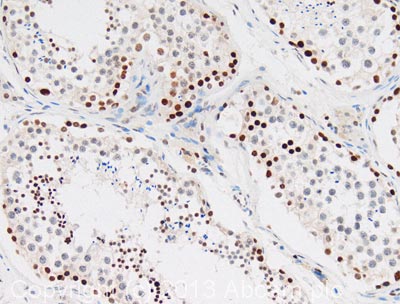![Histone H3 was immunoprecipitated using 0.5mg Hela whole cell extract, 5µg of Rabbit polyclonal to Histone H3 and 50µl of protein G magnetic beads (+). No antibody was added to the control (-).The antibody was incubated under agitation with Protein G beads for 10min, Hela whole cell extract lysate diluted in RIPA buffer was added to each sample and incubated for a further 10min under agitation.Proteins were eluted by addition of 40µl SDS loading buffer and incubated for 10min at 70°C; 10µl of each sample was separated on a SDS PAGE gel, transferred to a nitrocellulose membrane, blocked with 5% BSA and probed with ab18521.Secondary: Mouse monoclonal [SB62a] Secondary Antibody to Rabbit IgG light chain (HRP) (ab99697).Band: 17kDa; Histone H3](http://www.bioprodhub.com/system/product_images/ab_products/2/sub_3/2107_ab18521-196685-IPV022ab1852120m.jpg)
Histone H3 was immunoprecipitated using 0.5mg Hela whole cell extract, 5µg of Rabbit polyclonal to Histone H3 and 50µl of protein G magnetic beads (+). No antibody was added to the control (-).The antibody was incubated under agitation with Protein G beads for 10min, Hela whole cell extract lysate diluted in RIPA buffer was added to each sample and incubated for a further 10min under agitation.Proteins were eluted by addition of 40µl SDS loading buffer and incubated for 10min at 70°C; 10µl of each sample was separated on a SDS PAGE gel, transferred to a nitrocellulose membrane, blocked with 5% BSA and probed with ab18521.Secondary: Mouse monoclonal [SB62a] Secondary Antibody to Rabbit IgG light chain (HRP) (ab99697).Band: 17kDa; Histone H3

All lanes : Anti-Histone H3 antibody (ab18521) at 1 µg/mlLane 1 : Calf Thymus Histone Preparation Nuclear Lysate at 0.5 µgLane 2 : HeLa Histone Preparation Nuclear Lysate - Colcemid-treated at 2.5 µgLane 3 : Histone H2A Recombinant Protein at 0.1 µgLane 4 : Histone H3.1 Recombinant Protein at 0.1 µgLane 5 : Histone H4 Recombinant Protein at 0.1 µgSecondaryGoat polyclonal to Rabbit IgG - H&L - Pre-Adsorbed (HRP) at 1/3000 dilutionPerformed under reducing conditions.

ab18521 staining Histone H3 in human MEF cells by ICC/IF (Immunocytochemistry/immunofluorescence). Cells were fixed with paraformaldehyde, permeabilized with Triton X-100 and blocked with 1% serum for 10 minutes at 21°C. Samples were incubated with primary antibody (1/3000) for 10 hours at 21°C. A FITC-conjugated goat anti-rabbit IgG polyclonal (1/500) was used as the secondary antibody.See Abreview

ICC/IF image of ab18521 stained Hek293 cells. The cells were 100% methanol fixed (5 min) and then incubated in 1%BSA / 10% normal goat serum / 0.3M glycine in 0.1% PBS-Tween for 1h to permeabilise the cells and block non-specific protein-protein interactions. The cells were then incubated with the antibody (ab18521, 1æg/ml) overnight at +4øC. The secondary antibody (green)ÿwas Alexa Fluor© 488 goat anti-rabbit IgG (H+L) used at a 1/1000 dilution for 1h. Alexa Fluor© 594 WGA was used to label plasma membranes (red) at a 1/200 dilution for 1h. DAPI was used to stain the cell nuclei (blue) at a concentration of 1.43æM.

All lanes : Anti-Histone H3 antibody (ab18521) at 1/250 dilutionLane 1 : Whole cell lysate prepared from Saccharomyces cerevisiae WT (BY4741).Lane 2 : Whole cell lysate prepared from Saccharomyces cerevisiae delta hht1 HHT2.Lane 3 : Whole cell lysate prepared from Saccharomyces cerevisiae delta hht1 hh2-K9, 14, 18R.Lysates/proteins at 500000 cells per lane.SecondaryHRP conjugated goat anti-rabbit IgG at 1/10000 dilutiondeveloped using the ECL techniquePerformed under reducing conditions.

IHC image of Histone H3 staining in human testis formalin fixed paraffin embedded tissue section, performed on a Leica BondTM system using the standard protocol F. The section was pre-treated using heat mediated antigen retrieval with sodium citrate buffer (pH6, epitope retrieval solution 1) for 20 mins. The section was then incubated with ab18521, 1µg/ml, for 15 mins at room temperature and detected using an HRP conjugated compact polymer system. DAB was used as the chromogen. The section was then counterstained with haematoxylin and mounted with DPX. For other IHC staining systems (automated and non-automated) customers should optimize variable parameters such as antigen retrieval conditions, primary antibody concentration and antibody incubation times.

All lanes : Anti-Histone H3 antibody (ab31602) at 1 µg/mlLane 1 : Calf thymus histone lysateLane 2 : Calf thymus histone lysate with Human Histone H3 peptide (ab14949) at 1 µg/mlLane 3 : Calf thymus histone lysate with Human Histone H3 (mono methyl K4) peptide (ab1340) at 1 µg/mlLane 4 : Calf thymus histone lysate with Human Histone H3 (di methyl K4) peptide (ab7768) at 1 µg/mlLane 5 : Calf thymus histone lysate with Human Histone H3 (tri methyl K4) peptide (ab1342) at 1 µg/mlLysates/proteins at 20 µg per lane.
![Histone H3 was immunoprecipitated using 0.5mg Hela whole cell extract, 5µg of Rabbit polyclonal to Histone H3 and 50µl of protein G magnetic beads (+). No antibody was added to the control (-).The antibody was incubated under agitation with Protein G beads for 10min, Hela whole cell extract lysate diluted in RIPA buffer was added to each sample and incubated for a further 10min under agitation.Proteins were eluted by addition of 40µl SDS loading buffer and incubated for 10min at 70°C; 10µl of each sample was separated on a SDS PAGE gel, transferred to a nitrocellulose membrane, blocked with 5% BSA and probed with ab18521.Secondary: Mouse monoclonal [SB62a] Secondary Antibody to Rabbit IgG light chain (HRP) (ab99697).Band: 17kDa; Histone H3](http://www.bioprodhub.com/system/product_images/ab_products/2/sub_3/2107_ab18521-196685-IPV022ab1852120m.jpg)





